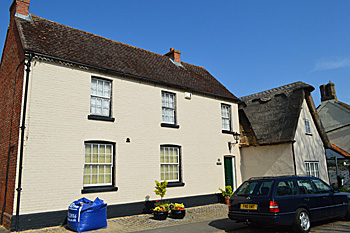The Royal Oak Public House Riseley

Oak House - 107 High Street April 2015
The Royal Oak Public House: 107 High Street, Riseley
When Riseley was inclosed in 1796 the Red Lion and land behind it were owned by Thomas George [A and MA24], who is listed as licensee in the countywide licensing register of 1822 [CLP13]. In between, however, Edward Wood is given in Land Tax returns as proprietor (i.e. licensee) [QDL].
By 1834 William Coote of Saint Ives [Huntingdonshire], brewer owned the Royal Oak and in that year he leased it to Thomas George for £12 per annum for fifteen years [WG408]. Presumably this Thomas George was some relation of the earlier one. In 1853 Coote conveyed the Royal Oak to Saint Neots [Huntingdonshire] brewer John Day [GK175/1]. Three years later John Hill and Mary day conveyed it and the brewery business to Francis Day. In 1919 Day and Sons Brewery was for sale [GK175/2]. The Royal Oak was bought by Bedford brewer Charles Wells [PSS3/3].
The Rating and Valuation Act 1925 specified that every building and piece of land in the country was to be assessed to determine its rateable value. The valuer visiting The Royal Oak [DV1/C217/27] found that tenant Samuel Rootham ("been here 38 years") paid rent of £9 per annum. Accommodation comprised a tap room, club room, bar parlour, private parlour, kitchen and four bedrooms. Average trade was about six gallons of beer per week and about four dozen bottles in the same period. The valeur commented: "Nice oak tree in front. Very pretty looking house" also "Tied rent very low. Too many pubs here. No trade".
Rootham also leased farm buildings. These comprised: a weather-boarded and tiled wood shed; a weather-boarded and tiled store shed with a loft over; a weather-boarded and thatched store; a weather-boarded and thatched fowl shed; a weather-boarded and thatched pigsty and weather-boarded and thatched stable.
The public house was listed by the former Department of Environment in June 1974 as Grade II, of special interest. The original building, which stands gable end on to the road, dates from the 17th century and is thatched. Alterations and additions were made over the next three centuries. The rear extension is 18th century and the south-west block, which is tiled and faces the road, is 19th century. The Royal Oak closed around 1995 and is now a private house.
Sources:
- CRT130Ris9: brief history of the Royal Oak
- CLP13: Register of Alehouse Recognizances: 1822-1828;
- WG408: Lease for 15 years: 1834;
- GK175/1: conveyance: 1853;
- PSS3/1: Register of Alehouse Licences - Sharnbrook Petty Sessional Division: c.1901;
- PSS3/2: Register of Alehouse Licences - Sharnbrook Petty Sessional Division: c.1903;
- PSS3/3: Register of Alehouse Licences - Sharnbrook Petty Sessional Division: 1904-1930;
- GK175/2: sale of Day's Brewery, Saint Neots: 1919;
- WL800/4 page 35: photograph: c. 1925;
- PSBW8/4: Register of Alehouse Licences - Biggleswade and North Bedfordshire Petty Sessional Divisions: c.1957-1995;
- Z53/96/17: photograph: 1962;
- PSBW8/3: Register of Alehouse Licences - Biggleswade and North Bedfordshire Petty Sessional Divisions: 1976-1980.
List of Licensees: note that this is not a complete list: entries in italics refer to licensees where either beginning or end, or both, dates are not known:
1796-1798: Thomas George;
1801-1811: Edward Wood;
1812-1832: Thomas George;
1834-1853: Thomas George;
1869-1876: William Bateman;
1885: Valentine Woolley;
1890-1934: Samuel Rootham;
1934-1935: Robert William Spooner;
1935: Clara Spooner;
1940: Arthur Wise;
1966-1969: William James Evans;
1969-1972: Ronald Bradshaw;
1972-1975: Thomas McDonald Clark;
1975-1979: Francis Robert Taylor;
1979-1982: Peter James Markham;
1982-1983: Owen Powis;
1983-1984: Stephen Paul Whitbead;
1984-1994: John William Boughton;
1994: Kenneth George Hawley and John Ernest Gibbs;
1994-1995: Andrew Glen Vidler and Stephen John Joy